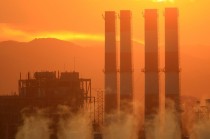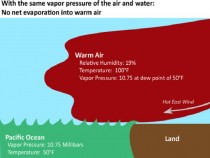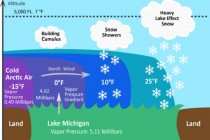Update: see Lubos Motl on Gavin Schmidt’s “There’s no theory that extremes should rise in general”. Also see this Climate Depot compilation.
ICECAP NOTE: Andy Revkin of all the journalists who cover the environmental beat is the one most likely to strike some balance although his readers object sometimes violently when he does and so he treads carefully. You probably saw the much ballyhooed story on a ‘paper’ in the once respectable Nature magazine that in its summary claimed
Here we show that human-induced increases in greenhouse gases have contributed to the observed intensification of heavy precipitation events found over approximately two-thirds of data-covered parts of Northern Hemisphere land areas.
Andy wrote today in the Dot Earth blog: “In scientific literature you rarely see statements so streamlined and definitive. For climate science, this is the equivalent of a smoking gun. News indeed. Add in the extreme floods last year (a period not included in the study) and you have more relevance, although Roger Pielke Jr. this morning notes the importance of distinguishing between analysis of certain kinds of extreme precipitation events and disastrous flooding.
The problem is that the Nature paper is not definitive at all, as you’ll see below.
None of this detracts from the importance of this work, or the overall picture of an increasingly human-influenced climate, with impacts on the frequency of gullywashers.
But this does raise big questions about the standards scientists and journals use in summarizing complex work and the justifiable need for journalists - and readers - to explore such work as if it has a “handle with care” sign attached.
This is not about “false balance”. This is about responsible reporting… So what’s the issue with the new study of bad storms and warming? It opens with an extraordinary summation, which is echoed in the news release disseminated by the journal:
Here we show that human-induced increases in greenhouse gases have contributed to the observed intensification of heavy precipitation events found over approximately two-thirds of data-covered parts of Northern Hemisphere land areas.
Just in case there’s any doubt in the scientific community, this is the news element in this otherwise creditable, but unremarkable[*], work.
At the tail end of the full paper, capping a paragraph about a weak spot in the analysis [ that the observed trend in extreme precipitation events exceeds what is produced by various climate models - comes a sentence about uncertainties:
There are, however, uncertainties related to observational limitations, missing or uncertain external forcing and model performance.
There’s no indication that those caveats (which included links to 9 cited papers) apply to the grand conclusion. Did the authors stress the uncertainties in discussions with journalists? It sure doesn’t look that way. Should the journalists have pushed harder when confronted with definitive language? To my mind, yes.”
Good for you, Andy. There are uncertainties in the analyses of the nature, frequency and varying causes of extreme events - whether they be heavy rains, snow, tropical systems, drought, record cold and heat. We can find natural factors to explain virtually any extreme. Indeed I and many other forecasters including Joe Bastardi and Piers Corbyn use these same factors to predict these events or extremes sometimes many months in advance.
In the words of the great Yogi Berra: “You can observe a lot just by watching.”
By Chuck Wiese, Meteorologist, Weatherwise Inc.
Al Gore told FOXNews’s Bill O’Reilly that the snowstorms of this winter were part of the pattern of changing climate expected by scientists and result from the warming earth airmasses with more moisture were running into a patch of cold air. Gore claimed: “These warmer air masses ( which Gore claims result from human carbon emissions that create atmospheric CO2 ) act like a sponge to moisture and soak it up until they hit a patch of cold air.” Gore then claims that this “extra moisture” contained in the warmer air causes more intense precipitation and thus heavier snowfall, and is all consistent with a warming earth.
These statements by Gore are sheer nonsense. While it is true that warmer air can hold more moisture than cold air, the temperature of the air has nothing to do with how much water vapor will ultimately be evaporated ( or as Gore puts it “soaked up") into it. That is determined solely by what is called the vapor pressure gradient that exists between a sample of air that may overly a plane of water. To examine this, we need to introduce the physical concept of vapor pressure. The vapor pressure is defined physically as the amount of heat energy required to vaporize one mole of water at 100 degrees centigrade at one earth atmospheric pressure.
In the example above, I took a hot continental air mass that is typically found in the summer months in the US (southwest) at a temperature of 100 deg F. If the dew point of this hot air mass was 50 deg F ( which it typically is in summer ) this would be VERY DRY air relative to its temperature of 100 deg F, having a relative humidity of only 19%. This is the kind of airmass that Al Gore claims would “soak up moisture” because it is so warm. So what happens if we moved it out over the Pacific Ocean so it could “soak up” some of Al Gore’s moisture? We see from the vapor pressures involved that this hot airmass is not going to do any such thing. Why? Because the vapor pressure of the ocean is the same as the vapor pressure of Mr. Gore’s hot air mass! Both the ocean and air have the SAME vapor pressure with the temperature of the water and dew point temperature of the air being equal which equals a vapor pressure 10.75 millibars in both. The vapor pressure gradient is zero in this case. This means that there would be NO NET EVAPORATIVE GAIN OF WATER VAPOR into this HOT air mass at all. As this HOT air moves into the “patch” of colder ocean, it will simply begin to cool to towards its dew point temperature, raising the relative humidity of the air but leaving little or no change in the absolute humidity because the ocean will easily take up the extra heat energy without raising its own temperature, which determines its vapor pressure (which determines actual water vapor content) which defines that “sponge” Mr. Gore was talking about.
So in what scenario would we find an airmass acting like a “sponge” and “soaking up moisture” as Mr. Gore claims happens with a warm airmass? If you’re laughing about now and guessing the opposite of what Gore claims you would be correct! The best example I could give regarding an airmass “soaking up moisture” would be from one that produces lake effect snowstorms, and that would be a source of COLD continental arctic air.
Let’s examine the physics of that in the illustration below:
In this scenario, we start with a COLD airmass, whose temperature at the north shore of lake Michigan is -15 degF, with a dew point temperature of -20 degF. We find the vapor pressure in such a COLD airmass is very low. The value is only .49 millibars. But when we compute the vapor pressure of Lake
Michigan, even with a temperature of 32 degF we find it to be much higher at 5.11 millibars. This creates a whopping vapor pressure gradient INTO the COLD airmass of 4.62 millibars! The effect this will have is unmistakable. As this COLD airmass travels over the warmer lake surface, it will be heated rapidly by the lake surface, but as it heats, the vapor pressure gradient will constantly feed a stream of moisture from the lake into the warming airmass and continually re-saturate it. Notice on the diagram that as the air is heated from underneath by the lake that the temperature difference between the air near the lake and higher up gets larger. This eventually causes this warmer and saturated surface air to overturn, causing a deep convective current to ensue, that depending on the 5 and 10 thousand foot temperatures will allow the air to overturn to these altitudes. This process continues to allow the COLDER air to lose and re-saturate moisture as long as we maintain the positive vapor pressure INTO the COLD air, which we do. As the cloud columns form and build from this process, precipitation begins to fall from them and continues on the south side of the lake as long as the wind fetch and supply of COLD arctic air remains on the north side.
Ask people who live Chicago Illinois and Buffalo New York about lake effect storms. They will tell you they observe on a frequent basis, snowfall totals that range anywhere from half a foot to several feet of snow depending on how long the COLD wind fetch across the lake persists. This COLD airmass would have started with a water vapor content of around .2 gKg-1 (grams of water vapor per kilogram of dry air ) and end up with approximately 3.2gKg-1 by the time it nears the south shore of the lake fully saturated because of the vapor pressure gradient. Yet that water vapor content is only 16% of what is found in one of those juicy tropical airmasses Al Gore claims “soak up moisture”. It is COLD, not warm air that “soaks up water vapor” from a water surface, and it is precisely because that air has a VERY LOW vapor pressure compared to any source of warmerwater that it over runs.
PDF has much more.
Reprinted with permission of author. See post here.
By Dr. Larry Bell, Forbes
California, marching to the beat of its own drum, is on the road to another economic minefield of its own making. On September 2, 2010, voters rejected an alternate Proposition 23 route, one that would have avoided the approved Assembly Bill 32 superhighway to disaster. Resulting cap-and-trade booby traps will be triggered in 2012 when the California Global Warming Solutions Act of 2006 is implemented. This legislation authorizes unelected officials at the California Air Resources Board (CARB) to establish a program enabling companies that cut greenhouse gas emissions to sell “allowances” to others that need them to meet reduction regulations targeted at 15% by 2020.

Well, there is still an outside chance that this won’t happen. San Francisco Superior Court Judge Ernest Goldsmith has recently ruled that CARB will be barred from implementing the proposed ARB 32 plan because it didn’t complete an environmental review required under the California Environmental Quality Act to determine if there are better ways to accomplish the same objectives. Want to hear the really funny part? Okay, get ready for this. According to Investor’s Business Daily, one of the plaintiffs in the case that originally backed ARB 32 passage, the Center on Race, Poverty and the Environment, joined the suit because it determined the proposed implementation of the plan was “too friendly to business.”
If ARB 32 goes forward CARB will give away allowances to the state’s 500 largest greenhouse gas emitters, letting those that reduce them sell excess allowances to others that don’t. CARB would later charge for those allowances to raise state revenues. They also seem inclined to allow up to 8% of the greenhouse gas reductions to be met through purchases of “offset credits” obtained from developing nations who purport to have realized emission reductions. Of course such transactions will lack transparency, and will most certainly be rife with fraud. In addition, they will not only increase energy costs, but also accelerate flows of capital and exports of jobs out of the state.
It’s not as if the state doesn’t have enough problems already. California has lost 34% of its industrial base since 2001, has one of the highest unemployment rates in the country (12.4%), and has run up unfunded pension liabilities for its state and local public employees that may be as much as $500 billion (roughly 17% of the nation’s $3 trillion total). A recent study conducted by the Pacific Research Institute predicts that AB 32 will produce an additional 150,000 state job losses by 2012, growing to 1.3 million by 2020. A 2009 study commissioned by the California Small Business Roundtable estimates that the new legislation will “result in a higher cost to California households of $3,857 per year”.
Cap-and-trade is typically promoted as an “environmental justice” initiative. This misleading claim is based upon three errant and deceptive premises: (1) that the legislation will help protect our planet from dangerous climate change and pollution; (2) that it is needed to wean California and the rest of the country and world away from excessive energy consumption; and (3) that it will incentivize energy technology and conservation innovations that will lead to independence from fossils and foreign oil.
The initial premise is wrong on two accounts. First, there is absolutely no evidence that any human-caused climate crisis exists. Second, there is no real likelihood that any attempts to reduce atmospheric CO2 emissions can be expected to have any measurable climate influence. Further, simply because the EPA, parroted by green marketers condemns CO2 as a “pollutant,” that claim does not make it so. Such a declaration only misleads people, and confuses this natural and essential molecule with real pollutants that truly should be restricted.
The second premise, that carbon restrictions are necessary for energy consumption control, belies inherent logic of free market economic incentives to advance conservation economies. Further, it empowers government to pick and subsidize winners, restrict choices, and intentionally drive up costs. The burdens of this zero-sum-gain strategy will fall most painfully upon low-income consumers and small-profit-margin businesses who can least afford them.
The third premise, that carbon penalties attached to fossil-fueled utilities will incentivize alternative technology innovations, is misleading in several respects. Heavily funded green marketing promotions fail to inform the public about the limited-capacity potentials afforded by “renewable” energy sources, most particularly in regard to urgent time frames required to substantially offset demands. Unfounded technology promises provide excuses for other agendas: expansion of government control and spending, and unwarranted mandates and subsidies for those who play the system. When bureaucrats are empowered to reward politics and promises over performance, taxpayers and captive consumers are left to cover the costs.
Those costs under AB 32 will be substantial . California refiners will be forced to begin to comply with a low carbon fuel standard this year, reducing the “carbon intensity” of transportation fuels 10% by 2020. This will most likely entail increasing the corn ethanol mix in petroleum, running up food costs, depleting water supplies, and causing environmental land damage while affording no net CO2 emission reduction. It will also impose costly refinery modifications and require and necessitate increased importing of higher quality, non-California crude oil feedstock.
Since most Californians don’t live in dense urban centers, the bulk of those extra expenses will be passed on to truckers, commuters and rural drivers. According to a December 20, 2010 Investor’s Business Daily article authored by Chuck Devore, some analysts are forecasting a resulting gasoline price shock of 30% to 80% within five years.
And what about those alternative non-fossil transportation possibilities? Environmental lobby resistance to oil and gas drilling doesn’t bode well for the future of hydrogen-fueled cars, because the primary feedstock of hydrogen is natural gas. Actually, hydrogen really doesn’t make any sense anyway. It requires lots more energy to obtain than it produces.
Then there are those nifty little electric cars. Unfortunately, they’re not great for commuting and carpooling on California freeways, don’t have much range, aren’t cheap, and need to be recharged at night. But isn’t that when the sun doesn’t shine, and the wind can’t be counted on to blow?
Building more nuclear power facilities might help...but then that’s not currently possible either. California won’t allow that to happen until a safe nuclear waste repository is created, and the Obama administration recently canceled development of the nation’s only approved storage site at Yucca Mountain in Nevada. This occurred after $10 billion has already been spent on the project.
Harsh economic and social realities will inevitably intrude upon prevailing magic kingdom fantasies. In the mean time, Snow White, please take heed. Put on your glasses and look more carefully. Those aren’t bluebirds of happiness circling overhead. They are vultures.




